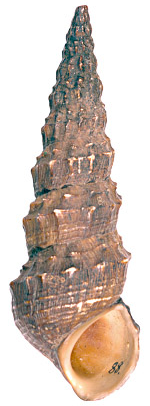Jagora asperata
| Jagora asperata | |
|---|---|

| |
| A shell of Jagora asperata from Philippines on display at the Museo Civico di Storia Naturale di Milano | |
| Scientific classification | |
| Kingdom: | |
| Phylum: | |
| Class: | |
| (unranked): | |
| Superfamily: | |
| Family: | |
| Genus: | |
| Species: | J. asperata
|
| Binomial name | |
| Jagora asperata (Lamarck, 1822)
| |
| Synonyms[1] | |
| |
Jagora asperata is a species of freshwater snail with an operculum, an aquatic gastropod mollusk in the family Pachychilidae. Jagora asperata is the type species of the genus Jagora.[1]
Description[edit]

The shell of an adult Jagora asperata can be as long as 50–80 millimetres (2.0–3.1 in) and has a width of about 18 millimetres (0.71 in). This shell is solid, dark brown to yellowish brown, highly tower–shaped, comprising up to twelve whorls. The apical whorl is truncated. The sculpture of the shell shows closely spaced axial ribs and spiral elements with tiny nodules.
The body of these snails is gray to black with filiform antennae. They are characterized by a unique reproductive system, including a long sperm gutter, a very short a spermatophore bursa and a prominent lateral ridge working as a seminal receptacle. Females carry eggs and juvenile stages within their mantle cavity. These snails feed on detritus and algae.
Distribution and habitat[edit]
This species occurs in the northern part of the Philippines, on Luzon, Leyte Island, Samar Island and several other small islands.[2] They live in small mountain rivers with stony or sandy bottoms.
References[edit]
- ^ a b Köhler F. & Glaubrecht M. (2003). "Morphology, reproductive biology and molecular genetics of ovoviviparous freshwater gastropods (Cerithioidea: Pachychilidae) from the Philippines, with description of the new genus Jagora". Zoologica Scripta 32(1): 35-59. doi:10.1046/j.1463-6409.2003.00100.x.
- ^ Köhler F. & Dames C. (2009). "Phylogeny and systematics of the Pachychilidae of mainland Southeast Asia – novel insights from morphology and mitochondrial DNA (Mollusca, Caenogastropoda, Cerithioidea)". Zoological Journal of the Linnean Society 157: 679-699. doi:10.1111/j.1096-3642.2009.00541.x.
